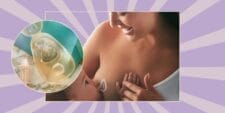7 Misconceptions About Hand Expression

The MilkinMama tells the truth about milking ourselves.
I started hand expressing milk when I went back to work and was trying to keep up with my baby’s bottle intake. It was just an addendum to pumping then, and I never considered that it could be more than that. That is, until my very first trip without baby, when I forgot some of my pump parts.
This meant that if I didn’t want my milk supply to drop significantly during my trip, I would need to find another way to get the milk out. And so I did — with my hands, and to my surprise, I got 29 ounces in the first 24 hours I was gone, which is, by anyone’s standards, some solid output.
That’s right — hand expression can be an efficient, pain-free, and time-saving way of getting the milk your baby needs — no pump needed. In fact, it can even make your life (parenting and otherwise) easier. But there are a lot of misconceptions about hand expression that stop new and seasoned nursing moms from realizing that, yes, their bodies are enough. From thinking that hand expression is too hard or too time consuming to believing, like I once did, that it’s only for emergencies, here are 7 myths about hand expression, debunked.
1. Hand expression takes too much time. “But doesn’t it take forever?,” people will ask me. If it took forever, I wouldn’t be telling you to give it a go. We’re busy parents who’ve just created and birthed humans from our bodies. Our time is so precious! A hand expression session can take anywhere from 2 to 30 minutes, longer if you take breaks. For many, it can be more efficient than pumping.
2. The pump is more efficient. Both electric and manual pumps rely on negative pressure, which is created when you pull away from an environment. But when a baby is nursing at the breast with a nice, wide latch, the nipple is pulled into their soft palate while the tongue presses into the breast tissue, creating a different kind of pressure that pushes into the breast. A baby uses both kinds of pressure, and this is why babies who have a good latch can remove far more milk than a pump can.
Hand expression allows a lactating parent to more closely replicate the action of a baby’s mouth: your hand grips your breast, and your fingers press into it. For many people, these two different motions together are more effective than the pump.
3. Hand expression is far more work than the pump. Once you get good at hand expression, it can be less work than the pump. After a hand expression session, there’s nothing to wash except bottles (or whatever clean vessel you used) and lids. Adding hand expression to your breast/chestfeeding toolbox also means having to pack less if you’re pumping at work or when traveling.
4. Hand expression is only for emergencies. This widespread misconception is likely due to the fact that hand expression is most commonly taught to parents whose babies aren’t latching, whose breasts are too full to be comfortable for baby and parent, or who are separated from their babies for some reason. This teaching is often done in the hospital by a lactation professional who puts their hands on the mother’s breast, either instructing her to press back into the chest wall and squeeze at the nipple, or just doing it for her.
But hand expression is another strategy to add to our menu of options for removing milk, and if we learn it outside of an emergency situation, we have a better chance of feeling comfortable with it to use it whenever we want or need to.
5. Hand expression is painful and tiresome. As a rule, hand expression should not be painful. Learning to massage and compress your breast or chest enough to remove milk, without causing pain, is a valuable skill that will serve you well. Worried about carpal tunnel, or a sore wrist or fingers? Focusing on your posture and using a method of compression that feels comfortable for you can prevent such problems.
6. Hand expression is impossible. I thought this too, and I hear it from almost every nursing parent I talk to. I get it. When I first watched the video of the women hand expressing after pumping, I thought, “There’s no way I could do that!” Others will say: “I tried and it didn’t work for me,” “my breasts are too small/large,” and “I can’t get more than a drop or two.” But there are a lot of different ways to massage and compress. So dabble, and see how it goes. Don’t give up — find the way that works for you.
7. Hand expression is weird. Maybe it is, but I don’t really care. It makes my life easier. We sometimes have issues with touching our own bodies, and being in tune with them. Hand expression allows us to get to know this incredible part of our bodies that is making food for small humans.
Touching our breasts or chest with our hands creates oxytocin, the same hormone that helps us fall in love with our kids the moment we see them, further helping the milk flow. It’s also a breast self-exam every single time we hand express, which can help us take note of any changes in our breasts or chest. So is it weird? Maybe. But it’s also helpful for reasons that support us, and our families, in the short and long term.
Pumped to learn more? Check out Go Milk Yourself: You Have Power. Express It! by Francie Webb, available on Amazon Prime. Prefer to learn live? Looking for a video? Take an online workshop, book an event, or rent a video from Francie’s company, TheMilkinMama.
Francie Webb is a mom of two who lives in Harlem, NYC. As founder and CEO of TheMilkinMama, she is dedicated to helping parents have more power, more freedom, and less stress. Francie loved (almost) every minute of the fourteen years she spent teaching middle school, yet she discovered a new calling as a doula and lactation professional after her two transformative births. She is currently studying to become an International Board Certified Lactation Consultant (IBCLC).
Photo by Laura Vladimirova of NYC Doula Love.
Want more info on hand expression? Check out our interview with Francie Webb.


































